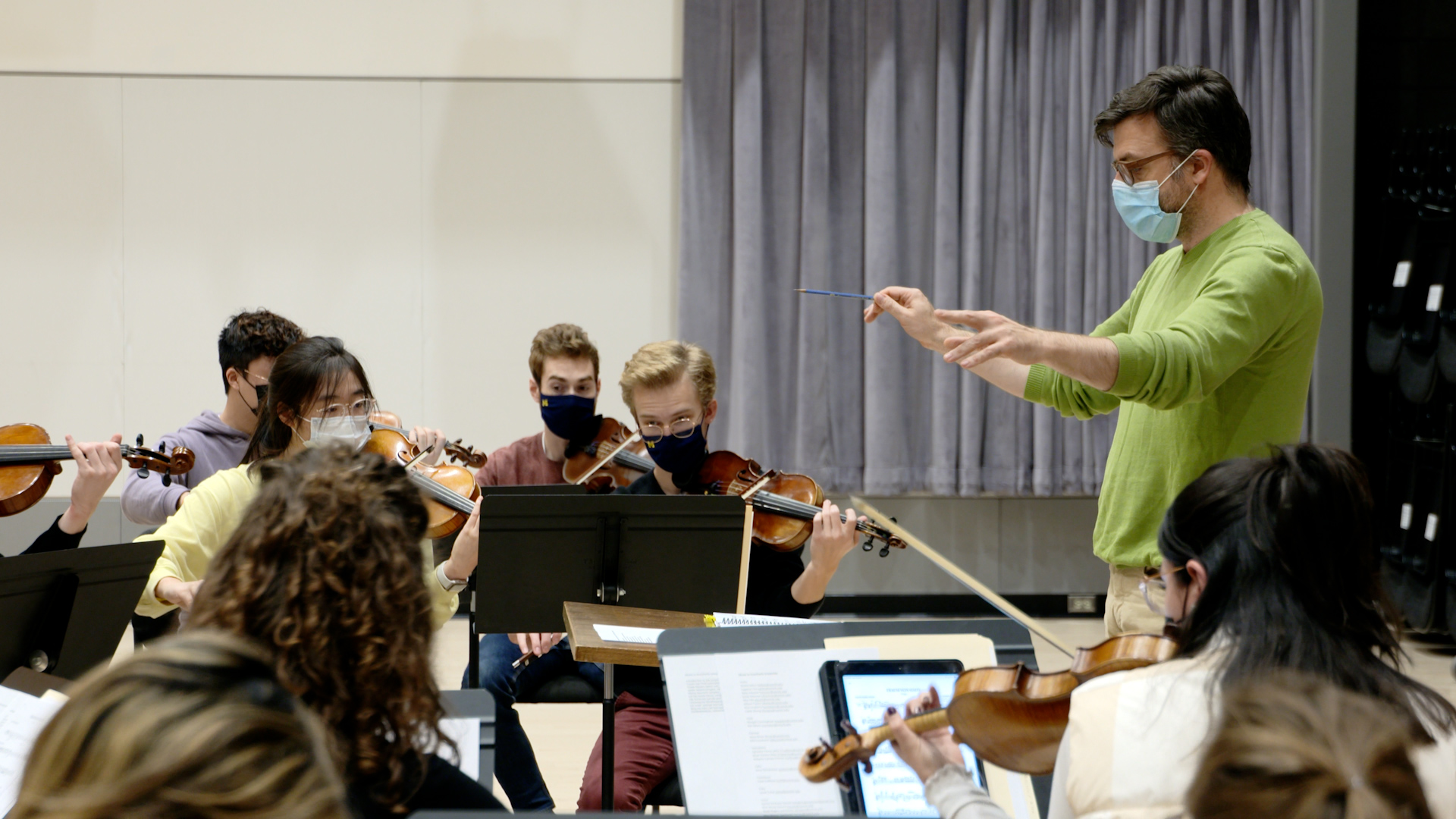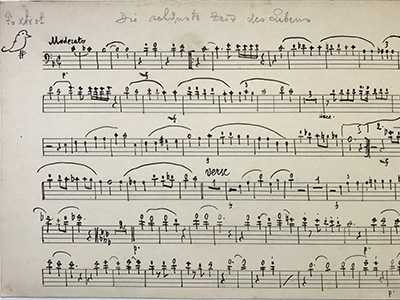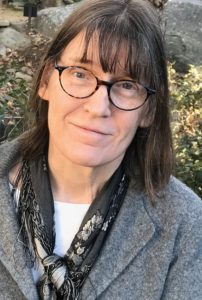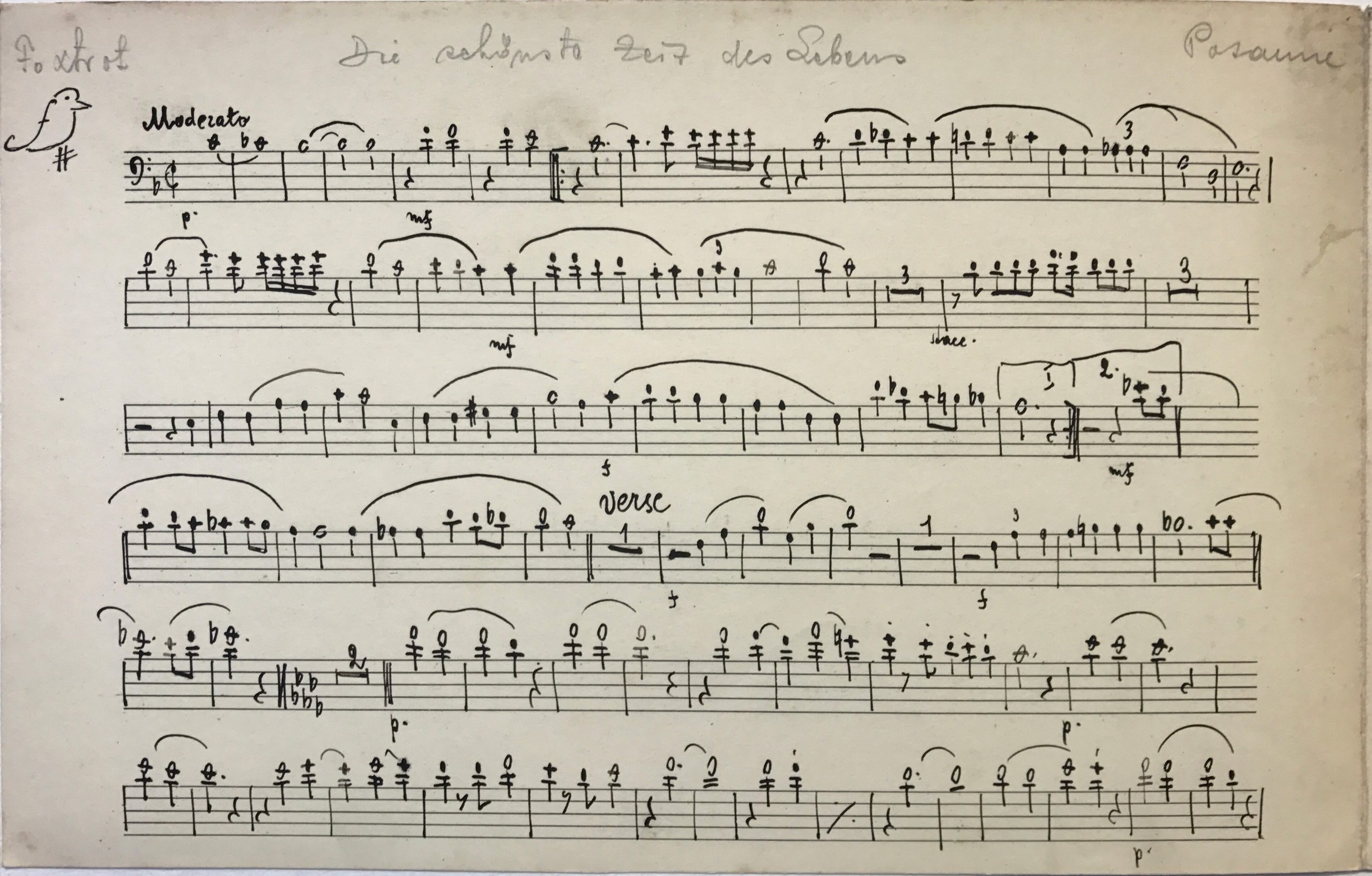For more than forty years, Patricia Hall, professor of music theory at the School of Music, Theatre & Dance (SMTD), has explored archives all over the world, looking for significant musical manuscripts that have been forgotten, lost, or ignored.
In 2016, she went on a somber quest, visiting the Auschwitz-Birkenau State Museum to search its collection for musical manuscripts. One in particular, a foxtrot called “Die schönste Zeit des Lebens,” struck Hall because of the horrible irony of its title, which translates to “the most beautiful time of life.” She learned that the music had been copied by hand and arranged by Polish political prisoners in the Auschwitz I men’s orchestra during World War II.
Music played a role in the Nazi concentration camps during the Holocaust, with official prisoner orchestras existing in most camps. The ensembles in Auschwitz, populated by many professional musicians, included a brass band and a symphony orchestra. Members of the ensembles were compelled to play an array of music for a variety of purposes, from background music as prisoners were marched to and from their work assignments to performing concerts for the SS, Hitler’s elite guard unit that ran the camps.
Hall returned to Ann Arbor with scans of the existing copies of the manuscript for that song and embarked on a collaborative effort with SMTD students and faculty – including conductor Oriol Sans, who was at the time an SMTD assistant professor of music – to present it in concert. The project also involved transcribing the handwritten copies into printed notation and creating a recording that closely matches how the song would have sounded as performed in Auschwitz in 1943. The recording, Hall said, was then returned to the museum and made available to researchers.
The story of Hall’s work with this song, and the public performance of “Die schönste Zeit des Lebens,” drew the interest of many who recognized its significance, from the perspective of music history and that of Holocaust scholarship. Hall was interviewed by several major media outlets, including NPR, the CBC, and the BBC, and an Associated Press article about the project ran in hundreds of publications nationwide.
A Series of Concerts
The level of interest surprised Hall, who made a subsequent visit to the Auschwitz-Birkenau State Museum in 2019 to continue the search. She found several more neatly handwritten scores of German songs and instrumental pieces popular at the time, including waltzes and tangos. Working again with SMTD students and Sans, who is now the director of orchestral activities and assistant professor in conducting at the Mead Witter School of Music at the University of Wisconsin, Hall prepared these additional works, including the original foxtrot, for a series of concerts.
An ensemble of undergraduate and graduate students will perform the pieces in concerts held at the Stamps Auditorium in Ann Arbor (May 17), the Zekelman Holocaust Center in Farmington Hills, Michigan (May 22), and the Museum of Jewish Heritage in New York City (May 25–26). The concerts include instrumental arrangements as well as songs, with vocals being performed by a quartet of singers from the SMTD Department of Voice. The singers will also recite lines from transcripts of the postwar testimonies of the copyists and arrangers, offering an important personal complement to the music being performed. The testimonies, Hall pointed out, “give the context of what it was like to work in this environment and to create these pieces in a concentration camp.”
Music from Auschwitz | Tuesday, May 17, 2022 | 8PM
Stamps Auditorium – 1226 Murfin Ave, Ann Arbor | free registration encouraged

An ensemble of SMTD students rehearses for the Music from Auschwitz concerts, led by conductor Oriol Sans.
The musicians in the Auschwitz men’s orchestra wrote arrangements to fit whatever combination of instruments and musicians were in the orchestra at the time, and they often represent unusual combinations of instruments. Each piece, Hall noted, “has a very, very unique sound to it that you wouldn’t get by even listening to a period recording of one of these hits.” Hall was especially surprised to find a tango arrangement that called for three saxophones, given that the Nazis considered it a degenerate instrument. While it was allowed in certain circumstances, the saxophone was essentially banned in Nazi Germany. Salvador Flores, a master’s student in saxophone performance and improvisation, explained that the Nazis’ antipathy toward the instrument was because it is “inseparable [from] and completely intertwined with jazz music and with African American culture.”
A Collaborative Effort
The process of preparing these pieces for performance took many months, requiring more than a little detective work by Hall and collaboration with several colleagues. Given that the musical manuscripts were handwritten, occasional errors in the scores were to be expected. In most cases, Hall had multiple copies of each piece, enabling her and others working on the project to compare them to determine the correct notes. With some pieces, entire parts were missing, and Hall had to track them down using a computerized database of older sheet music in Germany.
In one instance, she questioned a harmony that seemed highly unusual; after consulting with Ellen Rowe, Arthur F. Thurnau Professor of Jazz & Contemporary Improvisation and chair of conducting, Hall learned that, in fact, the harmony was very common in jazz arrangements in the 1930s. The idea to include recitations of the prisoners’ testimonies came from Eugene Rogers, director of choral activities and associate professor of conducting; he suggested they would provide a fuller sense of the prisoners’ experience, and Hall agreed.
Stephen West, professor of music, has played a vital role in working with the vocal quartet, coaching the singers and helping to shape their voices. And Hall noted the exceptional experience of watching Sans conduct the ensemble and “shape these pieces from a manuscript transcribed into standard notation into something that’s really very beautiful.” All of those involved appreciated the importance of the project as a unique learning experience. “Working on music of this historical significance is an incredible honor,” stated Robert Wesley Mason, a DMA candidate in voice. “It has reminded me of the importance of telling all aspects of history.” He spoke of the “multiple truths that exist” in regards to the prisoners in the Auschwitz I men’s orchestra: “In one case, their talents are being used against them in many ways, and at the same time, [being able to play music] is also something that is probably giving them comfort and keeping them sane.”
Bringing the Notes to Life and Keeping Stories Alive
The performances of this music provide a fuller understanding of one aspect of a concentration camp existence. “Before, these manuscripts were being preserved in an archive, but they weren’t being heard,” Hall noted. Some photos of concentration camp ensembles exist, but there was no aural record of how they sounded. With these concerts and the recordings that will be made, the notes on the page will be brought to life after decades in an archive. “It’s the first time audiences can hear these arrangements of these pieces since World War II,” said Hall. “You’re hearing them as close as possible to how they actually sounded, and you’re learning a great deal about the daily life of these musicians.” Hall has been contacted by children of Holocaust survivors who appreciated the opportunity to learn a bit more about what their loved ones experienced in the camps, experiences rarely spoken of by the survivors themselves.
“The most important aspect of what we’re doing with this project is the amplification of history,” said Mason. “As we get further and further away from a moment like this in history, we start to lose the firsthand accounts, we start to lose the witnesses who can speak to it in their own words. This is a way we keep those people and their stories alive,” he concluded. “Music really does have a remarkable power.”
Warning: This video contains topics that some viewers may find disturbing, including anti-Semitic and racist imagery.



